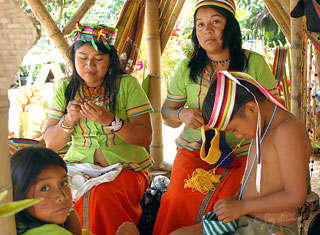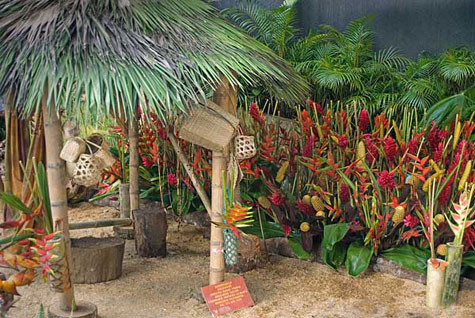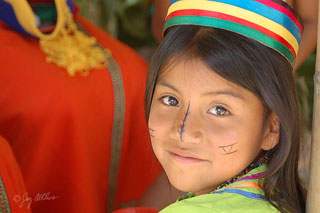Human Flower Project
Heliconia Shares: Welfare Colombian Style
What might ‘social security’ or ‘JobCorps’ look like in the ‘Land of Eternal Spring’?

An Embera family, members of an agribusiness training program in the village of Valparaiso, Colombia, bring locally grown flowers and locally made textiles to Medellin
Photo: Greg Allikas
Greg Allikas, a.k.a. Mr. Orchid Eye, spent part of August in Colombia during Medellin’s famed Feria de las Flores. Greg was attending the 15th Orchids, Birds and Flowers Show (Orquedeas, Pajaros y Flores) at the city’s Botanical Garden. “As you might expect, the flower show in this ‘City of Eternal Spring’ was spectacular,” he writes, “and the orchids varied and unusual. Although I am tempted to dazzle you with photos of the magnificent flowers I saw…,” Greg instead sent us photos of a Colombian family and notice of the ambitious community entrepreneurship program they’ve joined: Agronegocio Dâchinâmê, (trans. “Agribusiness Mother Earth”).
This human flower project is based in Valparaiso, Colombia. It’s dedicated to fortifying the Embera people who live in the village’s La Maria Indigenous Community. Greg writes that the effort intends to teach business skills grounded in local agricultural know-how, capitalizing on the region’s superb climate for growing things: “By strengthening strategies for producing and marketing exotic flowers and foliage, community members are developing the means for their own self-sufficient business model.”

Heliconias and other tropicals on view at the Agribusiness Mother Earth exhibit, Medellin Botanical Garden
Photo: Greg Allikas
Check out the heliconia and others beauties displayed among 75 exhibitors at the orchid convention.
Greg photographed one family as they worked on textiles in a thatched hut specially constructed for the convention. Their ancestors in the Embera tribe Cham (Chamies) emigrated to southwestern Antioquia “some 110 years ago from San Antonio de Cham, Risarald,” he explains. Currently, there are an estimated 71,000 Embera living in Colombia.
The Agribusiness Mother Earth program aims beyond self-sufficiency. Already it’s trained the Embera in “entrepreneurship, planning, accounting, community work,” and conflict resolution, as well as agriculture. A community savings fund was established with 7% of the first plantain harvest and 1% of the initial proceeds from flowers and foliage.
Talk about intensive farming! “The cooperative has 4 hectares (9 acres) with 8,000 plants from 40 species of heliconias,” Greg writes, “two hectares with 9,000 foliage plants and a half hectare of turmeric,” also 1,500 banana (plantain) trees, 400 fruit trees, a nursery and a nature trail. Thirty families are taking part.
 A girl from an Embera family joins a demonstration of textile arts at the 15th Orchids, Birds and Flowers Show, Medellin, August 2008
A girl from an Embera family joins a demonstration of textile arts at the 15th Orchids, Birds and Flowers Show, Medellin, August 2008
Photo: Greg Allikas
The project was begun by Comfenalco Antioquia, a privately-owned non-profit that provides services within Colombia’s social security system. It’s one agency of the country’s Family Compensation Funds, ” institutions of economic re-distribution and solidarity …created by Decree 118 of 1957 to which all Colombian employers should register by law.” This seems to be Colombia’s version of what we in the U.S. call “welfare.”
Agribusiness Mother Earth has been funded by many sources—the Generalitat Valenciana, the Spanish DNGO Petjades, the Government of Antioquia, and SENA, as well as Comfenalco Antioquia and its employees. And we note that sharp-eyed photographer Greg Allikas isn’t the only one who’s seen the promise of this endeavor; the United Nations Economic Commission for Latin America has recognized it, too.
Thanks for sending word, and images, Greg!

